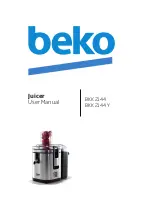
Use
• Start the appliance by turning the control dial to position ‘’1” (low speed) or position “2” (high
speed).
• The low speed setting is suitable for juicing soft fruits and vegetables.
• The high speed setting is suitable for juicing harder fruits and vegetables.
• Feed the selected fruits and/or vegetables into the appliance through the funnel a little at a time,
pushing them down using the food plunger (1).
• Make sure that you turn the food plunger so that the groove in the food plunger fits into the feed
chute properly.
• Long vegetables such as carrots should be fed into the feed chute point end first.
• Press the fruit and/or vegetables gently with the food plunger. Too much pressure reduces the
amount of juice extracted and can damage the appliance.
• Stop the appliance before removing the food plunger to add more fruit/vegetables in order to avoid
any splashes.
• Keep an eye on the fruit pulp holder and stop juicing before the holder becomes too full.
• Always turn off the power by turning the control dial to “0” position before taking off the lid.
CAUTION: Do not leave the appliance running for more than 3 minutes at a time. If the appliance
has been running for 3 minutes, allow it to cool down for 20 minutes before you use it again.
Tip
• If you line the fruit pulp holder with a plastic bag before using the appliance, it will be easier to clean.
• Use fresh fruits and vegetables - they contain the most juice
• Good foods for juicing include: pineapple, apples, cucumbers, celery, carrots, spinach, melons,
tomatoes and most citrus fruits.
• The various vareties of apple yield juice with different flavours and consistency. Experiment with
different combinations.
• Leafy green vegetables such as cabbage and spinach can be juiced. Roll the leaves into cylinders
of an appropriate size before feeding them into the feed chute.
• Fibrous fruits and vegetables as well as those with very firm flesh such as bananas, mango’s
papayas and avocados are not well-suited to juicing, as the result is often mashed fruit instead of
juice.
• All types of juice should be consumed right after juicing, as fresh juice quickly loses important
nutrients when exposed to the oxygen in the air. The taste can also be affected.
• Pure apple juice turns brown quickly when exposed to air. To prevent it discolouring, serve the apple
juice immediately after juicing or add a little lemon juice.
• Remember that fruit pulp can be used in cakes, vegetable lasagne, muffins etc.
Storage
• Ensure the appliance is clean and dry before storing
• The appliance contains sharp parts - keep out of reach from children
Cleaning
• Remove the plug from the wall socket and allow the apparatus to cool down before cleaning.
• The best way to clean the motor housing is with a damp cloth and, if necessary, a little detergent.
Do NOT immerse the motor section in any form of liquid.
• The centrifuge bowl, fruit pulp holder, base and all other detachable parts can be washed by hand
or in a dishwasher.
4


























